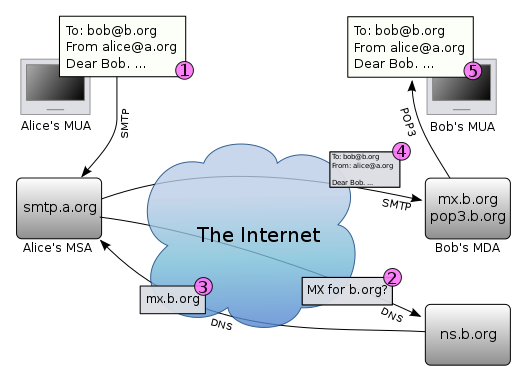
Electronic mail (or e-mail or email) is an Internet service that allows those people who have an e-mail address (accounts) to send and receive electronic letters. Those are much like postal letters, except that they are delivered much faster than snail mail when sending over long distances, and are usually free.
Like with regular mail, users may get a lot of unwanted mail. With e-mail, this is called spam. Some programs used for sending and receiving mail can detect spam and filter it out nearly completely.
To send or receive an email in the traditional way, you need a device (computer, phone etc.) connected to the Internet and an e-mail program (simply called mailer). Several formats exist for email addresses. The most common, called RFC 2822, looks like user@domain.com. E-mail messages are sent mostly by text, and sometimes by HTML style.
Some companies let you send and receive emails for free from a remote website. Gmail, Hotmail and Yahoo! are among the many that do this kind of service, which is known as "web mail". Webmail does not follow the pattern below exactly because the webpage is a web application and takes care of many details by itself. Rather, the below pattern is what takes place when using the traditional method (described in the previous paragraph).
Microsoft invented its own "communication protocol" (or set of rules) for sending and receiving mail, called "Exchange". Exchange protocol works entirely differently from the traditional method and is not explained here.
Traditional method

This diagram gives an example of what happens when email is sent from one person to another using the traditional method. In this example, Alice is sending email to Bob.
- First, Alice writes a message to Bob in her e-mail program. Her e-mail program puts the message together along with some other information, such as her email address, the address of the person she is writing to, the time at which she is sending her message, and so on. When it is ready, Alice's mail program sends the message to a special computer called a mail server (or a Mail Transfer Agent) using some rules called the Simple Mail Transfer Protocol.
- The mail server that Alice is using to send her message (smtp.a.org) takes Alice's message and looks at the address to see where the message is being sent. The mail server then goes out on the internet and tries to find the mail server that Bob is using. It does this by talking to a Domain Name System (DNS) server, which keeps records about how to find different computers on the internet, including mail servers.
- The DNS server gives Alice's mail server the proper address for the server that Bob is using to receive his email (mx.b.org).
- Alice's mail server sends the message to Bob's email server, which puts it into Bob's mailbox.
- Bob opens his e-mail program and downloads his messages using one of two sets of rules—either the Post Office Protocol (POP) or the Internet Message Access Protocol (IMAP). His messages include the new message from Alice.
Other Features
- You can send files along with your emails by using the Attachment feature. This is a common way of sending longer documents, spreadsheets, photographs etc. to other people
- The CC (Carbon Copy) function lets you send a copy of the email to other people
- the BCC (Blind Carbon Copy) function also lets you send a copy of the email to other people. This function hides the names of the recipients from each other
Other websites
- RFC 2822 Internet Message Format. April 2001